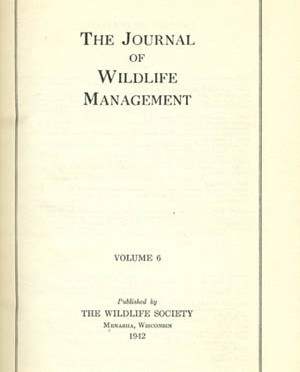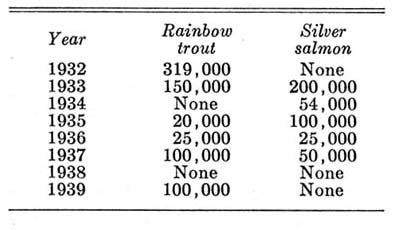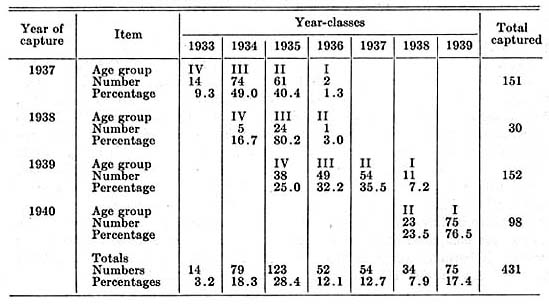 |
|
Table 4 – Silver Salmon – Representation of Year-Classes in Collections of Different Years |
As to salmon (Table 4), the 1935 year-class constituted 40.4 per cent (age group 11) of the 1937 catch, 80.2 per cent (age group 111) of the 1938 catch, and 25 per cent (age group IV) of the 1939 collection. The 1939 year-class gave promise of being another strong group, providing 76.5 per cent of the captures in 1940.
 |
|
Fig. 1. Calculated growth of year-classes of rainbow trout. Calculated lengths for corresponding years of life in different calendar years are connected by broken lines. |
 |
|
Fig. 2. Calculated growth of year-classes of silver salmon. Calculated lengths for corresponding years of life in different calendar years are connected by broken lines. |
In Wisconsin rock bass (Hile, 1941) the numerical strength of a year-class has a definite correlation with good growth. No such correlation is evident in the Crater Lake salmonids when the growth curves (Figs. 1 and 2) are compared with the year classes (Tables 3 and 4); but if fishes of the same age group taken in different years (Tables 1 and 2) are compared as to amount of growth, it becomes apparent that the trout of age groups 111, IV, and V showed better growth in 1937 and 1938 than similar ones in 1939 and 1940. The favorable growth can be correlated with the strength of the year-classes, since the greatest number of the strong year-classes of 1933 and 1934 were captured in 1937 and 1938.
With the salmon, those of age group I caught in 1940 had attained a length of 10 inches when captured, exceeding any other group I of any year. As stated above, these fishes showed indications of continuing as a strong year-class. Age group I11 of the strong 1934 year-class also was abundant in the 1937 captures. Furthermore, this age group I1 grew more in that year than similar ones in other years. Contrarily, in the strongest year-class, 1935, the age group I11 of the 1938 captures does not exceed the growth of other groups. Consequently good growth is not always correlated with strong year-classes.
Hile (1936; 1941) found some correlation between good growth and strength of year-classes in ciscos and rock bass with meteorological and limnological fluctuations. He reviews the work of others who have found similar correlations in other species. These changes also have been shown to affect the survival of a new hatch. These correlations are interesting, but not within the scope of this paper. Some correlations probably could be found if complete meteorological and limnological data were available.
The greatest difference in sex ratio was in group I of salmon caught in 1940, 79 per cent of males being recorded. As a rule, however, the females predominated in the older age groups of both yields species.
Observations continue to support the evidence of the 1938 report that the life cycle of the salmon in Crater Lake is four years.
Little variation has been noted in the general condition of the fishes from year to year.
Creel Census
A summary of the creel censuses (Table 5) shows that more fishes were caught per hour of angling during July than in August in all years. In 1938 a study was made to compare day fishing and evening fishing by a group of rangers who kept separate records of their angling before and after 3: 00 p.m. During July and August they fished 26 hours between 8 : 00 a.m. and 3 : 00 p.m. and caught an average of 0.17 fish per hour per angler. The same men, using identical tackle and in the same months, also fished between 3:00 p.m. and dusk and then averaged 0.86 fish per hour per angler. Boats are not available to the public for early morning or evening fishing, because of local conditions; otherwise anglers would obtain greater yields.
Natural Reproduction Vs. Stocking
If we assume random sampling for the scale collections, the percentage composition of the year-classes as recorded in Tables 3 and 4 can be applied to the catches reported in the creel census (Table 5) and the yield of the year-classes correlated with the history of stocking (Table 6). There was little or no correlation between stocking and yield to the creel. Indeed, the largest catch of trout was from the 1934 year-class. There were no fishes planted in that year according to the official records of the Park. There was also a catch of trout of the 1938 year-class in which year no fishes were planted. These data show that natural reproduction plays a dominant role in the maintenance of the population and stocking, by present methods, only a minor one.
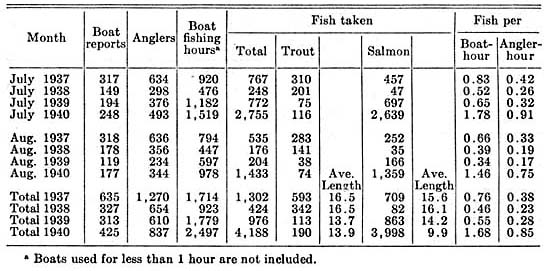 |
|
Table 5 – Summary of Creel Censuses at Crater Lake, Oregon |
Similarly there was a large catch of salmon from the 1939 hatch in which year none was stocked. There was also a catch of salmon of the 1938 hatch when none was stocked, which indicates that salmon reproduce in the lake.
Stomach Analysis
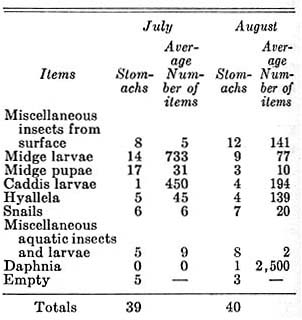 |
| Table 7 – Stomach Contents of Salmonids in Crater Lake, 1940 |
During the summer of 1940, 79 stomachs were collected from fishes taken by anglers. Data on weight, length, and sex were recorded, and ages determined by examining the scales. No differences in food habits could be noted between the two species or among the various age groups within each species.
Apparently the relative amounts of the various items in the diet depend upon the availability of these foods (Table 7). In August there were many terrestrial insects floating on the lake surface and these constituted a much larger proportion of the diet than in July when very few were observed. Brode (1938) found that Daphnia made up a considerable part of the diet of both species. One stomach collected in 1940 contained Daphnia. Furthermore, noDaphnia were found in tow-net samples from 100 meters to the surface, and none was found in Fumerole Bay where numbers were reported by Hasler (1938).
Fisheries Management Problems
Alm (1939) found that salmonid fishes in Lake Vattern, Sweden, grew 4.8 inches per year over a 5-year life span. Cooper (1940) recorded the growth of salmonids in Maine lakes to vary from 3.3 to 5.8 inches between the fourth and fifth years of life. Ricker (1938) recorded growth of 4.9 inches 1 between the first and second years of life in the sockeye salmon of Cultus Lake, British Columbia. Schindler (1940) recorded the growth of two races of salmonids in an Alpine lake in Bavaria, where one grew 4.2 inches in both the first and second years, whereas the other grew 4.4 in the first year, 4.2 in the second, and 3.6 in the third. As compared with fishes in the lakes just mentioned, it is obvious that growth in the Crater Lake fishes is nearly at the optimum. There is no evidence of crowding or that the density of present fish population is injurious to good growth.
The potential production of salmonids in Crater Lake appears to be greater than the actual production. In 1940, when the maximum catch was recorded, we estimated that only 3.2 fishes (about 4 pounds) were caught per acre. If the fishes that died from natural causes could be added, the true productivity figure would be much greater. The actual catch at present is much below the possible catch since only a fraction of the area of the lake is available to anglers. Current facilities limit intensive fishing to within about a 2-mile radius of the boat livery.
Wingfield (1940) reported that brown trout do not grow at temperatures lower than 6°C. If this condition applies to Crater Lake salmonids, it would mean a long growing season (see records of summer temperatures in Hasler, 1938). Early spring, late fall, and winter temperatures have not been recorded. The lake never freezes over completely and the autumn is protracted; such a long period of moderate temperature would be favorable to growth.
Young fry were observed on many occasions, but attempts to catch them failed prior to the stocking periods; consequently no proof of natural reproduction was gained until the scale method of age determination was applied. No fishes of either species were planted in 1938, but in 1939 and 1940 fishes were caught whose scales indicated they were hatched in 1938. Likewise no salmon were stocked in 1939, yet those of the 1939 hatch were dominant in the creels of 1940.
Early indications of natural reproduction are found in the historical records. On December 6, 1901, the geologist J. S. Diller, wrote to Judge W. G. Steele (letter in files of National Park Museum, San Francisco): “Am very glad to learn that you put some fish in Crater Lake as early as 1888. It is probable that the ones we saw [summer, 19011 were some of your plant. We saw over twenty, so that it is probable your thirty-seven must have multiplied somewhat or else we happened to come across a large number of the members of your family. We saw no small ones whatever. Those we saw ranged from about six inches to the neighborhood of thirty inches in length, and the larger ones were generally more or less white [probably a Saprolegnia infection common in Crater Lake fish] on the back and sides as is often the case with old salmon far up in the rivers . . . ” These, however, could have been fishes reportedly planted by a California minister before 1900.
